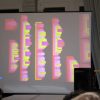Tidal from Alex Maclean is a domain-specific language built on top of Haskell, and his new Texture system creates more of a diagramming notation. Dave Griffiths has built his live coding environment, Fluxus, in Racket which is used in Program by Design and Bootstrap CS education projects. Dave did all his live coding at Dagstuhl using his Scheme Bricks, which is a Scratch-like block language that represents Scheme forms. (See here for Dave’s blog post on the Dagstuhl seminar.) How many of our undergraduates have ever seen or used notations like these? How many have considered the design challenges of creating a programming notation for a given domain? Consider especially the constraints of live coding (e.g., expressiveness, conciseness, and usability at 2 am in a dance club). David Ogbourn raised the fascinating question at Dagstuhl of designing programming languages for ad hoc groups, in a collaborative design process. Some evidence suggests that there may be nine times as many end-user programmers in various domains as professional software developers. Do we teach CS students how to design programming notations to meet the needs and constraints of various domains and communities? (via Live coders challenge CS to think about expression again | Computing Education Blog) click through for more tasty ideas from Mark Guzdial on live coding…
